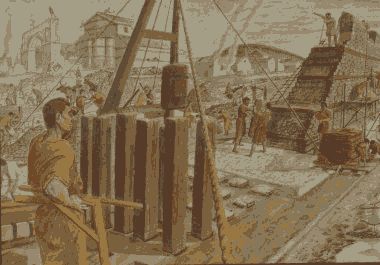
This is the Podcast which is a taster for the Roman Walk on Saturday 16th December 2023 starting at Monument Tube Station. This is a London Walks Walk by Kevin Flude. To book click here.

The Past brought to Life

This is the Podcast which is a taster for the Roman Walk on Saturday 16th December 2023 starting at Monument Tube Station. This is a London Walks Walk by Kevin Flude. To book click here.
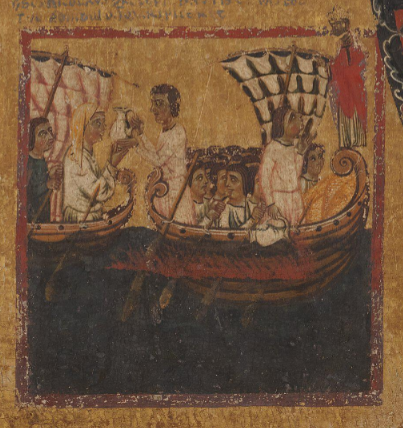
Santa Klaus was, originally a 4th Century Bishop from Asia Minor who saved three girls from prostitution by throwing golden balls through their window enabling them to marry with a good dowry. He, also, saved three boys from beheading. So he became the patron saint of children. He died on the 6th of December in Myra, present day Turkey. From the moment of his internment his tomb flowed with the myrrh. In 1087, the Normans from Apulia raided Myra, then under the control of the Seljuk Turks, with a gang of 67 men and stole his remains, to bring them to Bari, in Southern Italy. Before his arrival there were 6 churches dedicated to St Nicolas in Bari. In 1969, Pop Paul VI revoked his Feast Day as he decided ther was no evidence St Nicholas was a real person.
Representation of the balls can still be seen on pawnbroker’s shop, and the gifts Nicholas gave led to the exchange of gifts to honour him. They were originally given on December 6th, his feast day. The tradition of Santa Klaus was taken by the Dutch to the United States and mixed with other traditions, including the English Father Christmas, to create our modern spirit of Christmas.
Boy Bishops

The idea of Boy Bishops may come from a tradition established by Saturnalia. This was the festival, in the Roman world, when servants exchanged duties with masters and mistresses. The medieval Christmas was ruled over not only by the Lord of Misrule but also by Boy Bishops. It was a tradition that was attacked in some quarters but defended by others on the basis of the humanity of the custom, the empathy it engendred and the fun it could instigate.
They were elected on December 6th (Childermass) It was stopped by Henry VIII, although later revived and practised to this day in the Cathedrals of Hereford and Salisbury. The Boy Bishops wears full ceremonial gear and takes part in ceremonies and services for three weeks.
There are also medieval records that speak of the custom:
“two children’s copes, also a myter of cloth of gold set with stones.”
St. Mary-at-Hill, London Church Accounts
1549 “For 12 oz. silver, being clasps of books and the bishop’s mitre,
Westminster Abbey, St Pauls & St Nicholas Cole Abbey London inventories
“The vj myter of Seynt Nycholas bysshoppe, the grounde therof of whyte sylk,
garnysshed complete with ffloures, gret and small, of sylver and gylte, and stones
Also records at St Pauls record: una mitra alba cum flosculis breudatis ad opus episcopi parvulorum baculus ad usum episcopi parvulorum;’
St Nicholas Cole Abbey in the City of London,
This Church to St Nicholas is first mentioned in the 12th Century and was never an Abbey. The Cole part of the name is thought to refer to a ‘Coldharbour’ which was a traveller’s or poor persons shelter from the cold.
There is an inventory dating to the Reformation that records vestments for children at St Nicholas. The Church was rebuilt by Christopher Wren after the Great Fire, and is, possibly, the location where Trotty Veck stands awaiting employment as a messenger or runner, in Dickens’s second greatest Christmas Book after the Christmas Carol. The story is more a New Year story than a Christmas story.
For more on boy bishops look at this, and look at this 1935 film about Boy ~Bishops in Compton, Guildford.
Middle Temple, like the other Inns of Court in London also had a Winter period of f ‘condoned disorder. This continued through to Christmas and beyond to Candlemas. It was presided over by a Lord of Misrule, or in the Middle Temple’s case a Prince of Love. The Revels of 1597-8 were republished in 1660. Each December students, barristers and Benchers create and perform the Inn’s annual Christmas Revels. With thanks to https://www.middletemple.org.uk/about-us/history/elizabethan-and-jacobean-times
First published December 6th, 2022. Revised and republished 6th December 2023
Below, I give links to the Late November and early December Posts I have revised and republished. But, first, I would like to tell you about a great lecture I heard at the British Museum, this evening. It was given by Dr Emma Southon on her book about women in the Roman Empire. Her viewpoint was that a study of women in the Roman Empire gives a radically different insight into the Roman world than the traditional. One full of humanity rather than normal evidence which is, generally, about wars, and Empires and bravery and horrific cruelty and ambition and honour. She started with the story of Turia, whose extraordinary epitaph on her tombstone miraculous survived and gave her husband’s view of his extraordinary wife, and his utter sorrow at his loss on her death. Below, is a review of the book and a link to a podcast with the Author.
So, here are the December posts. December 1st and 2nd give an overview of December and the meaning of Winter. December 3rd is about Advent and the fact that you were not allowed to marry during Advent. December 4 gives a Shakespearean view of a cold winter’s day, and a composition by Vaughan Williams.
And late November posts, November 28th tells some interesting tales, both ancient and modern, about Eels, Pies, Rock ‘n’ Roll and my horror of Jellied Eels. November 29th, tells you how to make a ‘dish of snow’ and introduces Ice Houses. November 30th is about Scotland and St Andrews. Like them if you like them! And share them if you want to share them.
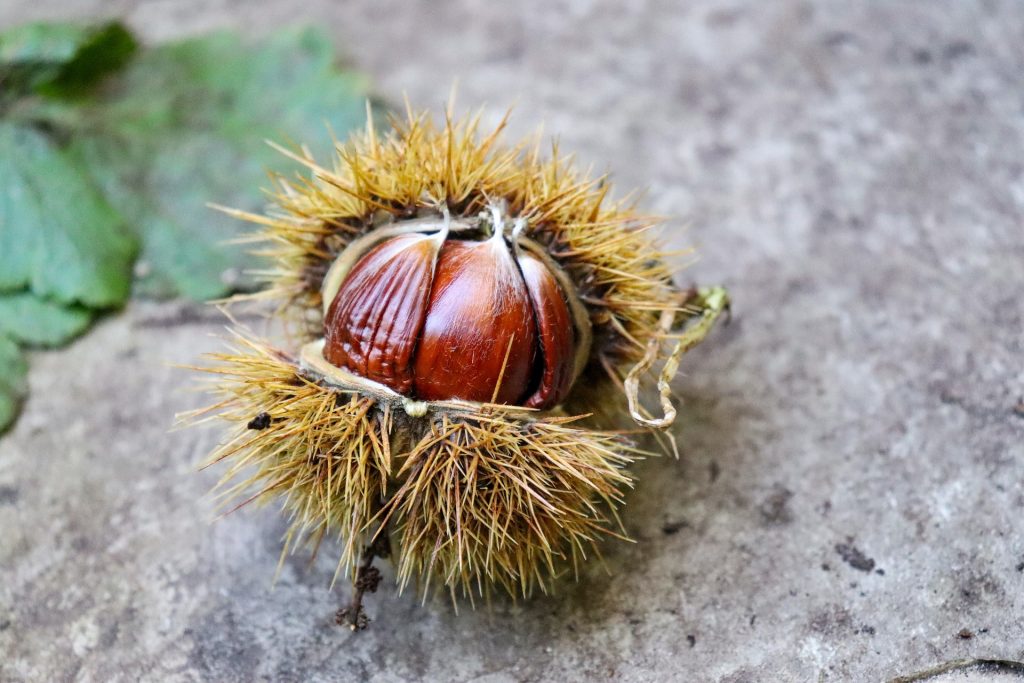
In Lia Leendertz’ lovely ‘The Almanac – A Seasonal Guide to 2022’ she lists the following as in season for foraging:
Crab Apples and sweet chestnuts
Roots: Dandelion, horseradish, Jerusalem Artichokes, and wild garlic
Wild Greens: chickweed, dandelion, and wintercress
Game: Hare, rabbit, pheasant, and venison
Sweet Chestnuts were introduced by the Romans and have long been a feature of Christmas. They can be ‘baked, roasted, boiled or microwaved’. You need to prepare them by scoring a cross in them; otherwise they will explode when cooked. They are often sold by street vendors (there is often a seller on the Millennium Bridge on the way to Tate Modern in London) and, in my family, are always a part of the stuffing for the Turkey. They can also be candied, puréed or stored in syrup. (The Woodland Trust Foraging in November and December).
John Evelyn, the 17th Century Diarist and author of a book on trees (Sylva, or A Discourse of Forest-Trees and the Propagation of Timber) wrote that the nuts were:
‘delicacies for princes and a lusty and masculine food for rusticks, and able to make women well-complexioned’
He complained that in England they are chiefly given to pigs to eat.
Chestnut meal was also used for whitening linen and for making starch. Marones, imported from Italy, France, Switzerland, and S. Germany contain 15% sugar and so were used to make a thick syrup and a ‘very usable’ sugar, from which Marons Glacés are made.
The wood of the chestnut is very useful and is/was used for building, pit props, furniture, poles for hops etc. but is nowhere near as long-lasting as oak.
Medically, they were used for treating convulsive coughs such as whooping-cough, where the leaves were infused in a pint of boiling water. (A Modern Herbal by Mrs M Grieve)
First Published on 3rd December 2022, Revised and republished in December 2023
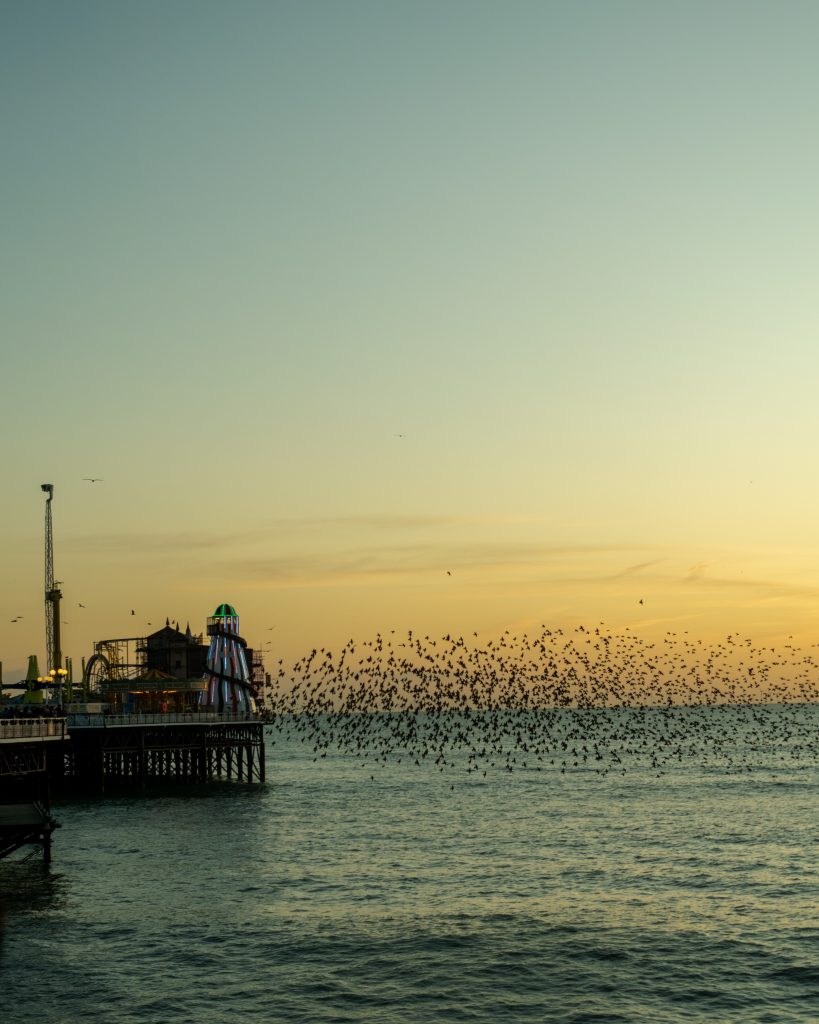
Starlings begin to roost in September but their numbers increase as November passes. The RSPB says:
They mainly choose to roost in places which are sheltered from harsh weather and predators, such as woodlands, but reed beds, cliffs, buildings and industrial structures are also used. During the day however, they form daytime roosts at exposed places such as treetops, where the birds have good all-round visibility.
RSPB Website
Early evening, up to 100,000 birds will rise above their roosts wheeling and turning in tight formations. Starling numbers have been declining because of ‘loss of permanent pasture, increased use of farm chemicals and a shortage of food and nesting sites in many parts of the UK.’2022 was a particularly bad year but, a count in Brighton in March 2023, suggests numbers were considerable up on 2022. (Starling Numbers Up)
See the above RSPB website for more information which also contains video.
Sacred Birds
Starlings were sacred to the Celts and were used for divination by the Romans – their augurs scrutinised the geometric patterns made by the murmurations to interpret the will of the Gods. In the Welsh Mabinogian a starling appears in the story of Bran, God-King of prehistoric Britain and his sister, Branwen, who was married to the King of Ireland.
To cut a long story short, (a version of which you can read on my February 18th’s blog post here), Branwen was banished to the scullery. So she trained a starling to send a message to her brother. He took an army over the Irish Sea to restore her to her rightful state, but Bran was mortally wounded in the battle that followed. He told his companions to cut off his head and take it back to the White Hill, London. His head was as good a companion on the way back as it was on the way out, but the journey home took 90 years. At last they got to London and his head was buried on the White Hill, near the Tower of London, and as long as it were there Britain was safe from invasion. This was one of the Three Fortunate Concealments and is found in ‘the Triads of the Island of Britain.’
I am giving a Walk on the Myths, legends, and Archaeology of London, for London Walks on 4th February.
Shakespeare and Starlings
Shakespeare in Henry IV Part 1 has Hotspur, annoyed with Bolinbroke say:
I’ll have a starling shall be taught to speak nothing but ‘ Mortimer,’ and give it him
Now if you think the idea of a talking starling is nonsense have a look at this video.

Almost ‘one in three women have been subjected to physical and/or sexual violence at least once in their life.’ says the UN on its page Ending Violence Against Women Day.
In writing my Almanac of the Past, I have been struck by how violent are most of the stories of the Saints of the early Catholic Church. At the bottom of this post, you will find an essay touching upon this thorny subject. And click here for research on violence against women. Their results are not good news countries that speak English. South Africa is the worst, the USA 7th, Australia 11th, UK 12th, and New Zealand 15th. They admit the figures are difficult to interpret as what is being counted is reported crimes. It is likely that the worst countries are those where women do not feel free to report sexual violence.
Today is St Catherine of Alexandria’s Day, which makes an appropriate Saint for the UN Day. So I have updated this very interesting story and republished it today. Have a read.
Also, buffed up and republished are the following seasonal posts:
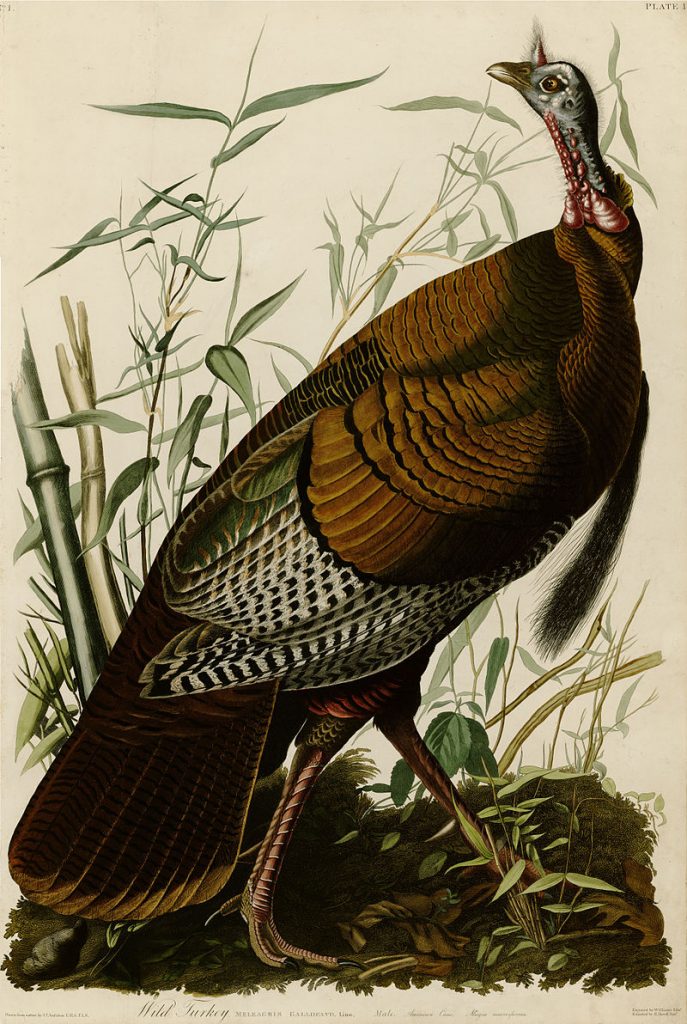
Thanksgiving is a festival given over to celebrating God’s Bounty. There are unanswerable debates about which was the ‘First’ Thanksgiving but the date of the 4th Thursday in November was set by Abraham Lincoln. It is basically a harvest festival, but was adopted by Lincoln as one method to unite a divided nation during the Civil War.
Thanksgiving today is mostly roast turkey with stuffing, cranberry sauce, mashed potatoes and pumpkin pie, with many other variants and additions such as a first course of soup, and vegetables like brussel sprouts and broccoli. Very like an English Christmas dinner, but replacing the Christmas Pudding with pumpkin pie.
As to what the first Pilgrims would have eaten is not known, but their chronicler Edward Winslow noted:
“Our harvest being gotten in, our governor sent four men on fowling, that so we might after a special manner rejoice together, after we had gathered the fruits of our labours; they four in one day killed as much fowl, as with a little help beside, served the Company almost a week.”
https://www.history.com/topics/thanksgiving/first-thanksgiving-meal
So the birds shot by 4 marksmen would have been wild turkey but also other birds such as ducks, geese, and swans. Seafood; Mussels, lobster, and eel were also available.
As to ‘gathering the fruits of our labors’. This might have included onions, beans, lettuce, spinach, cabbage, carrots, and peas. Stuffing might be seasoned with sage, thyme, parsley, marjoram, fennel, anise or dill, The Pilgrims had plenty of Corn from their first harvest which would have been turned into cornmeal, and eaten as a mush if savoury or sweetened with molasses as a porridge, or made into cornbread, or for stuffing.
Indigenous Wampanoag Americans might have been present, but only to investigate the shooting of canons in celebration by the Pilgrims. Relationships were tense between the natives and the immigrants. Some Indigenous Americans consider it a day of mourning; others use it as a day of gathering for the family, but generally, consider images of the Pilgrims and Indigenous Americans sitting down peacefully celebrating together to be ‘a lie’. (Native Americans and the First Thanksgiving.)
First Published on 24th November 2022, Republished on 23rd November 2023
Content moved to:
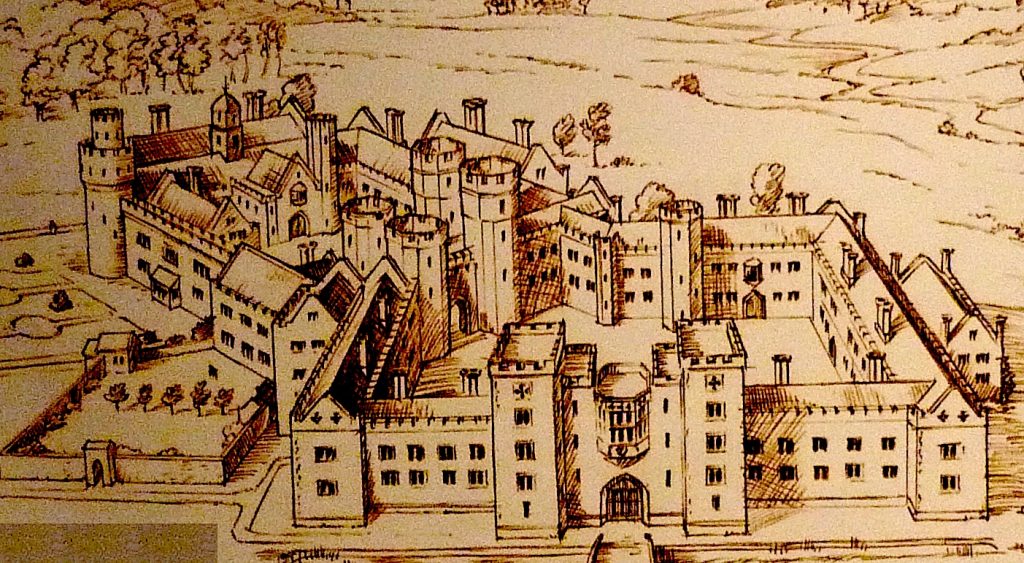
I was interested in this site because it was one of the many palaces owned by Henry VIII, and it began as a moated manor house before a transition into a small red brick courtyarded Palace, as seen above. Henry had, if my memory serves me well, approximately 57 Palaces and Manor Houses. 16 in the London area and 11 along the River Thames
But what I really liked when I visited the website was the charm of this lovely video by the Enfield Archaeology Society. Now those who know the wonderful TV Sitcom called the ‘Detectorists’ starring Toby Jones, Mackenzie Crook, Diana Rigg and others, will recognise the styling of the amateur archaeologists – all looking like rumpled would be Indiana Jones’s! Very English.
https://www.enfarchsoc.org/elsyng/
The good news is that the show is having an extended Christmas Special outing this year.
I have revised and republished the following Almanac of the Past posts.
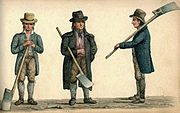
Content moved to: